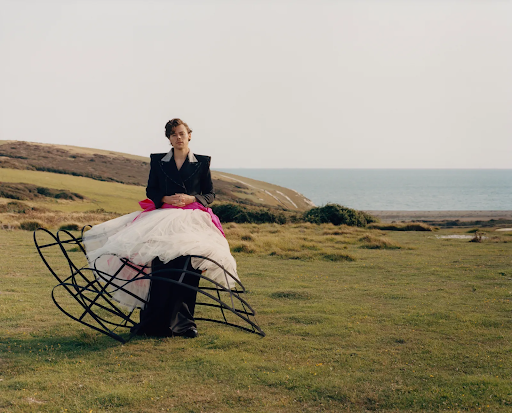Does Harry Styles Mark a New Era in Gender Neutral Fashion?

Image Courtesy of Tyler Mitchell
By Katherine Plunkett
Harry Styles was the first man to appear solo on the cover of Vogue in December 2020. The image has now become iconic and sparked many conversations regarding how Styles chose to don a dress for the cover. One of his critics is Billy Porter, an actor in the TV series Pose who is also known for wearing dresses on the red carpet. In an interview with The Sunday Times, Porter commented on the acclaim Styles received for the cover.
“I feel like the fashion industry has accepted me because they have to. I’m not necessarily convinced and here is why. I created the conversation [about non-binary fashion] and yet Vogue still put Harry Styles, a straight white man, in a dress on their cover for the first time,” Porter said.
Porter’s argument is a valid one; however, his claim is not entirely correct. Harry Styles has been photographed in dresses and wearing non-binary fashion long before the Vogue shoot, nor is he straight, though he does not label his sexuality. He has often discussed his love of fashion and how he doesn’t see clothing as gendered.
“Many borders are falling — in fashion, but also in music, films, and art,” Styles told L’Officiel Hommes. “I don’t think people are still looking for this gender differentiation. Even if the masculine and feminine exist, their limits are the subject of a game. We no longer need to be this or that.”
While Harry Styles isn’t the first or only celebrity to sport dresses and non-binary fashion, he is one of the most visible. He was named Lyst’s most influential dresser of 2020, the first man to do so. As a result, he has played a prominent role in the conversation on gender neutral fashion in this generation.
It is important, however, to recognize that Styles plays a role in a larger picture. As Billy Porter suggested, he is not the first, but neither is Porter. Some of music’s biggest names of the past were known for their nonbinary fashion, from Prince, to Freddie Mercury, to David Bowie’s Ziggy Stardust. Bowie specifically has influenced many fashion designers and other artists alike, including Harry Styles. In addition to Porter and Styles, Billie Eilish also receives a lot of attention for her gender-neutral looks.
So where did nonbinary fashion originate? Historically, the divisions between male and female clothing were very different, and it wasn’t until the 19th century that the skirt became only for women. The modern concept of unisex clothing was born in 1968 with the “Space Age” in which designers explored new silhouettes and patterns that had no historical gender associations.
Today, there is a decreasing level of gendering when it comes to clothing among Gen Z. Not only are designers such as Jean-Paul Gaultier and Vivienne Westwood moving towards gender-neutral fashion, but the generation as a whole. According to a study done by the University of Michigan, the number of teens who identify as gender-nonconformist has more than doubled in the past two years. In an interview with The Guardian, Christina Zevranos, the head of PR and a gender-neutral clothing shop stated that 56%of teens report shopping outside of their assigned gender.
While LGBTQ+ celebrities such as Bowie, Porter, and Styles played a large role in starting these conversations, gender-neutral fashion has expanded beyond them. Porter expressed his discontent with this occurrence in regard to Styles’ Vogue cover; however, it seems to be that the majority of Gen Z welcomes gender-neutral fashion regardless of sexuality.
The normalization of gender-neutral fashion is increasing significantly, raising questions as to exactly who it will include in the future. A recent Vogue article questioned, in the wake of Billy Porter’s comments and Harry Styles wearing a dress on his current tour, “if we’re ever going to move beyond a boy in a dress being news?” While Porter is correct in implying that the LGBTQ+ community is responsible for starting the conversation on gender-neutral fashion, as it becomes more normalized one can’t help but wonder: shouldn’t all fashion be for everyone, regardless of gender identity or sexuality? Isn’t that the point, to be more inclusive?
It seems that, from the rising number of teens who shop outside their gender and the Vogue article on the sensationalism of men wearing dresses, our society is moving in a direction in which there will be little to no gender barriers regarding clothing. Today, there exists three divides in the fashion world: male, female, and gender-neutral. What will mark a true change is when we cease to distinguish between any of these as well as to be shocked by those who see no distinctions as well.







